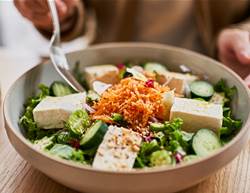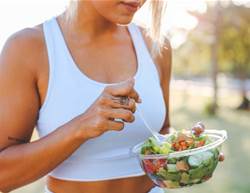With so many new diets floating around, it's hard to decipher the good from the bad. Here's a breakdown of the best and worst diet trends around through the lens of a qualified dietitian.
NORDIC
WHAT IS IT?
Move over Med, the Nordic diet is here. This eating pattern mimics that of the traditional Nordic countries (Norway, Denmark, Sweden, Finland, and Iceland), and has a strong focus on sustainability. It’s rich in plant foods, whole grains (like barley, oats, and rye), beans, chickpeas and lentils, and canola oil, with some lean meat and fish included occasionally.
PROS & CONS
There’s not a lot of scientific evidence supporting the Nordic diet (yet!), as it’s a relatively new area of nutrition research. But there is some evidence that it can improve heart health and help with weight loss. With an abundance of high-fibre plant foods on the menu, this diet is one worth following.
NOOM
WHAT IS IT?
Noom is an online course with a focus on behaviour change. The program allows you to log your meals and track your activity, and provides personalised feedback to help you build healthy habits… for good. It promises to help you lose weight and improve your fitness, and the results are rather promising.
PROS & CONS
Research from The University of Sydney ranked Noom as the best quality weight-loss smartphone app. In the same study, the app also earned the number one position for scientific accuracy, and had the second-best score when it came to behaviour change techniques, too. If you’re looking for a tech-based solution to help improve your wellbeing, Noom is the one to try.
FLEXITARIAN
WHAT IS IT?
‘Flexible vegetarianism’ is a way of eating that’s mostly plant-based, with only occasional serves of meat and fish. It celebrates fresh produce, whole grains, and legumes (like beans, chickpeas, and lentils), but doesn’t completely wipe animal foods off the menu – the idea is that you just try to cut back. A typical day could include baked beans for brekkie, a tofu salad bowl for lunch, and a big batch of roasted veggies with a piece of grilled salmon for dinner.
PROS & CONS
Research suggests the flexitarian diet is a great one to follow. It may improve your metabolic health, reduce your blood pressure, and even cut your risk of diabetes. It could be a good thing for your waistline, too, with several studies linking the flexitarian diet to weight loss. An added bonus is that by focusing on plants, you’ll ramp up your intake of fibre – good news for gut health. Plus, flexitarianism isn’t overly restrictive, which means you’re more likely to stick to it long-term.
ALKALINE
WHAT IS IT?
The alkaline diet is based on the idea that certain foods increase the acidity of your blood, while others have a more alkalising effect. Devotees claim the more acidic your bloodstream is, the more likely you are to gain weight and also experience inflammation. The acid-producing culprits include animal foods like red meat, chicken, and fish, as well as chocolate, wheat, and alcohol.
PROS & CONS
Although it sounds like a good idea, the science just doesn’t stack up. While it’s true that food can impact the acidity of your urine, that doesn’t correlate to changes in the acidity of your blood. Your body has its own extremely tight controls over the acidity of your bloodstream because minor changes can be lethal. Nonetheless, the alkaline diet encourages you to bump up your consumption of fruit and veg, which is always a good thing.
PEGAN
WHAT IS IT?
What do you get when you cross Paleo and vegan eating patterns? The Pegan diet! Picture this: veggie-packed scrambled eggs for breakfast, tuna salad for lunch, and lean meat with three veg for dinner, plus a handful of nuts and seeds for snacking throughout the day.
PROS & CONS
With a focus on fruit and veg, healthy fats, and a mixture of plant and animal proteins, as well as a goal to reduce your intake of processed foods, the Pegan diet has a lot going for it. But it also limits grain foods, dairy, beans, chickpeas, and lentils – which are all crucial for a well-balanced, healthy diet. Overall, this diet is far too restrictive, and unnecessarily cuts out a raft of health-giving foods.








